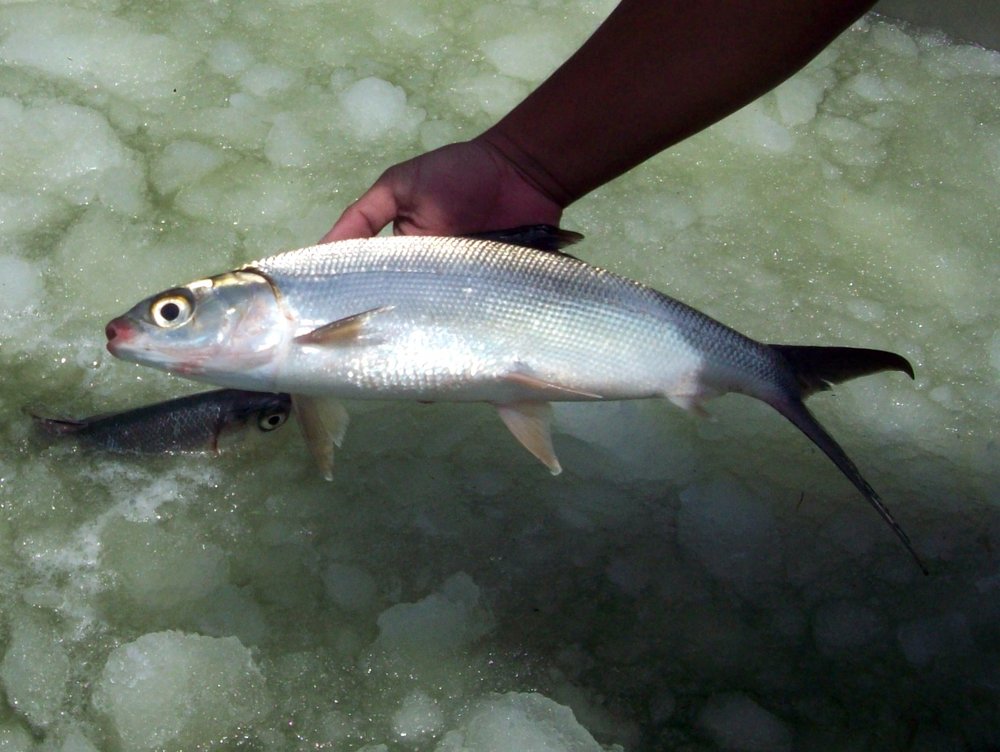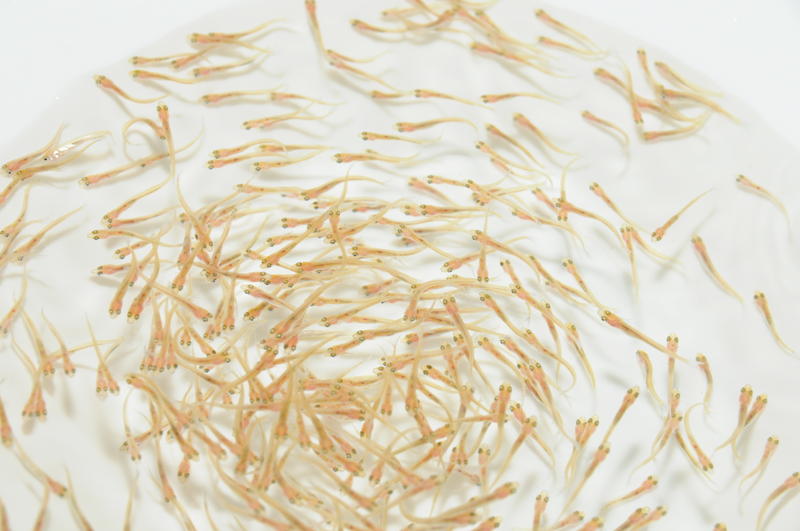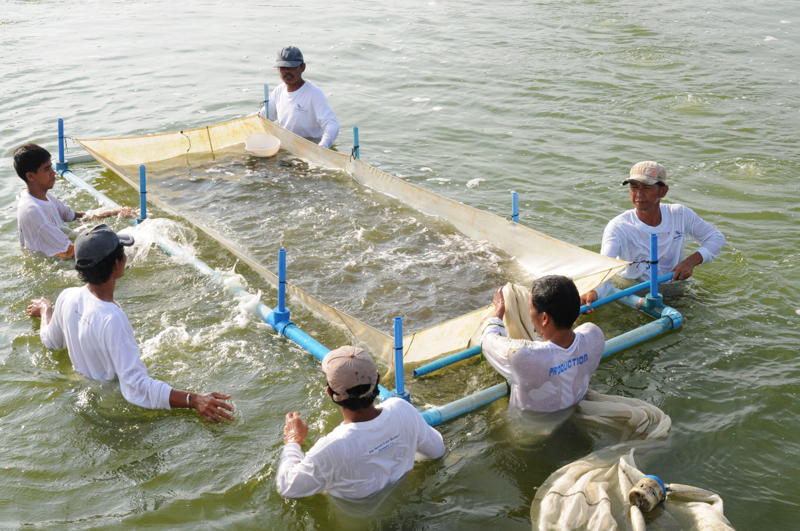
Destruction of natural habitats mean fewer fish.
Davao City, 6 February 2010. “The backbone of Philippine aquaculture” is how bangus farming has been regarded by most fishery experts. Although commercial production of bangus dates back more than a century ago, it was only in recent years that significant growth of the industry was realized.
Today, the Philippines is one of the top bangus producers in the world, along with Indonesia and Taiwan. “Until recently, the country has contributed around 55 percent share of the world bangus production,” said Dr. Rafael D. Guerrero III, former executive director of the Philippine Council for Aquatic and Marine Research and Development (PCAMRD).
The Philippines has been exporting bangus to other countries like the United States, England, Canada, and Japan. “The main consumer market, however, is the United States, where there are large Filipino communities,” Dr. Guerrero said.
Sleek and silvery, beloved because of its mild, sweet flesh, and its melt-in the-mouth belly fat, bangus is a favorite Filipino fish. In Metro Manila, the national fish is rated first-class. Its popularity of bangus can be gleaned in such recipes as bangus en tocho (fried bangus served with a sauce of any of the following: tahure, tokwa, or tausi), bulanglang na bangus (with eggplants, ampalaya, sitao, malunggay, onion, tomatoes, rice washing and bagoong), rellenong bangus (formerly a party dish; now available even in school cafeterias), and bangus lumpia.
Also known as milkfish, bangus (scientific name: Chanos chanos) is most closely related to carps and catfishes. It occurs in the Indian Ocean and across the Pacific Ocean, tending to school around coasts and islands with reefs. A warm water species, it prefers water temperatures between 20-33 degrees Centigrade.
In the Philippines, bangus can be raised anywhere. However, the top bangus producing provinces are Bulacan, Pangasinan, Capiz, Iloilo, and Negros Occidental. The most recent report released by the Bureau of Agricultural Statistics (BAS) show that the combined production of these five provinces alone accounts for more than 50 percent of the country’s total production.
Raising bangus can be done employing different production systems in freshwater and in brackishwater. “Depending on the available resources and level of management, the culture methods can vary from the traditional or extensive system, the modular or semi-intensive to the intensive system,” according to Milkfish: A Basic Domestic Need Commodity, a primer published by PCAMRD.
The semi-intensive system is an improvement of the traditional system where fingerlings are stocked at a higher density. With natural and artificial feeds, bangus fingerlings are stocked at densities of 6,000 to 12,000 per hectare. With dependence on natural food in the traditional system, low stocking densities of 1,000 to 3,000 fingerlings per hectare are applied. In this method, the culture period is longer thus allowing only one or two croppings a year. The modular pond system, on the other hand, allows a continuous operation and makes possible four to six croppings per year.
To make fishponds and fish cages productive throughout the year, adequate supply of bangus fingerlings is necessary. “Historically, milkfish fry abound in the country, especially during the fry season in the months of April to October,” the PCAMRD primer reports. “During recent years, the number collected has been dwindling.”

Farmed fingerlings are preferred to wild catch.
Among the causes cited for the diminishing supply of bangus fry were destruction of natural habitats brought about by the extensive conversion of mangrove areas to fishponds, destructive fishing methods and environmental degradation, among others.
“With the decrease in seed supply, the cost of fry and fingerlings has increased significantly over the years,” the primer said. To save the bangus industry from downfall, some have imported fingerlings from Taiwan and Indonesia; although others thought this option was not practical as the fry were very expensive.
Enter Finfish Hatcheries, Inc. (FHI), which selling bangus fry and fingerlings, among others. “We have been in the bangus fry production business since 1997,” says Rene B. Bocaya, FHI’s national marketing manager.
According to Bocaya, the price per piece of wild bangus fry was P1.00 a decade or so ago. “With the introduction to the market of hatchery produced fry (local and imported), the price now ranges from thirty to forty-five centavos per piece only. The hatchery-produced fry doesn’t only give very big savings to the fishpond operators, but it also provides them good quality and steady supply throughout the year.”

Intensive cultivation of bangus in the Philippines.
As a result of steady supply of bangus in the market, there are now processing plants for bangus value-added products. The foreign exchange earnings from bangus exports has been reported to be about US$15 million.
In Sarangani Province, where the FHI’s hatchery is located, bangus production has increased considerably. Actually, the hatchery is in Lun Masla, Malapatan. Here, about 13,000 breeders are maintained and managed to produce bangus eggs on a daily basis throughout the year. The eggs are collected, cleaned and hatched. The hatchlings are grown to the marketable sizes in 18-21 days in larval ponds. During the growing period, they are fed with a mixture of planktons and commercial feeds.
The breeders are 50% males and 50% females. “It is tedious to sex the fish individually and tag them,” Bocaya explains. “We have some breeders that are more than 25 years old and are still breeding in groups well.”
It takes 5 years for a bangus to mature sexually. FHI selects breeders for commercial production only when they are 8 years old. The female mature breeder, called sabalo, can produce seven kilos of eggs in one year. And one kilo consists of 750,000 eggs.
Bangus spawns in ponds in frenzy at night. The sabalo release the eggs while the males discharge the milt. Fertilization happens externally in the pond water. There is no need for hormone induction for mature breeders. The eggs are collected in nets in the early morning. They are cleaned and placed in the larval ponds immediately.
“The bangus eggs hatch in the ponds within 24 hours,” Bocaya informs. “The hatchlings feed on the yolk sac for about 2-3 days. They undergo morphological transformations. As first feeds, the larva are supplied natural food in a mixture of zoo- and phyto-planktons. Commercial feeds are provided in the last quarter of the production.”
Bangus is grown in a number of stages and in varying degrees of culture intensity depending on the grower’s production design and the nature of the growing environment. The simplest bangus value chain is the three-stage system of a nursery stage, a transition stage and a grow-out stage.
In the nursery, bangus is grown from fry (kawag-kawag) to fingerling (hatirin). In the transition stage, the fingerlings are grown to juvenile (garungan). In the grow-out stage the juveniles are grown to marketable sizes.
In the grow-out stage, bangus is produced in a number of categories depending on the pond structure the capitalization and the grower’s production design. Traditional extensive ponds using lablab as feeds normally seed 2,000 juveniles of 50 grams in size.Lablab production is takes 6 weeks. A well-prepared lablab pond can produce 500 kilograms of fish biomass. With 2,000 juveniles stocked, the grower is able to produce 300-gram fish in three to four months from seeding.
Bangus grown in marine cage systems.
In intensive ponds with aeration, growers can produce 8,000-10,000 kilograms of bangus fish in a hectare. Stocking density to grow 500-gram fish is about 20,000 juveniles per hectare. In fish pens in Laguna Lake, juveniles of 30 to 50 grams are stocked at 50,000 per hectare. There is no feeding needed as the lake provides the algae that the bangus feed on.
In marine sea cages, juveniles of 30 to 50 grams are stocked at a rate of 20-50 per square meter depending on the site and the business plan of the grower. Harvest can reach up to 30-40 kilograms per cubic meter of 500-gram bangus in six to eight months.
According to Bocaya, at least 50 percent of the costs in intensive pond systems goes to feeds. The other costs that figure are electricity, water, labor and pond maintenance costs. In marine cage systems, feeds are 80 percent of the costs. In extensive systems, lablab production is still 40 percent of the costs.
“On the average, gross profits are at about 25 to 30 percent of selling price on a good year across all production systems,” Bocaya points out.
No wonder, sales of hatchery-bred fingerlings are increasing. When they were new, the fish operators and growers were skeptical about using the hatchery-bred fingerlings. They thought that those caught from the wild were more hardy.
However, the perceptions of bangus farmers have changed, Bocaya said. They now prefer the hatchery-bred fingerlings because they are more uniform and they also grow faster. Those from the wild usually have a survival rate of 50 to 60 percent while those from the hatchery usually have 82 to 85 percent survival rate.
FHI now sells hatchery-bred fingerlings all over the country. It delivers only when the minimum volume of order is 500,000 pieces. “Generally, the buyers pick-up the fry from our sales offices,” Bocaya says. Buyers can buy fingerlings from their main sales office at 2286 Alsons Building, Pasong Tamo Extension in Makati City. They have offices also in Bacolod City, Iloilo City, and Alabel, Sarangani Province.
